Here are some helpful online resources for learning more about the Rio Grande River Basin and New Mexico’s water use policies.
On this page:
New Mexico Water Use
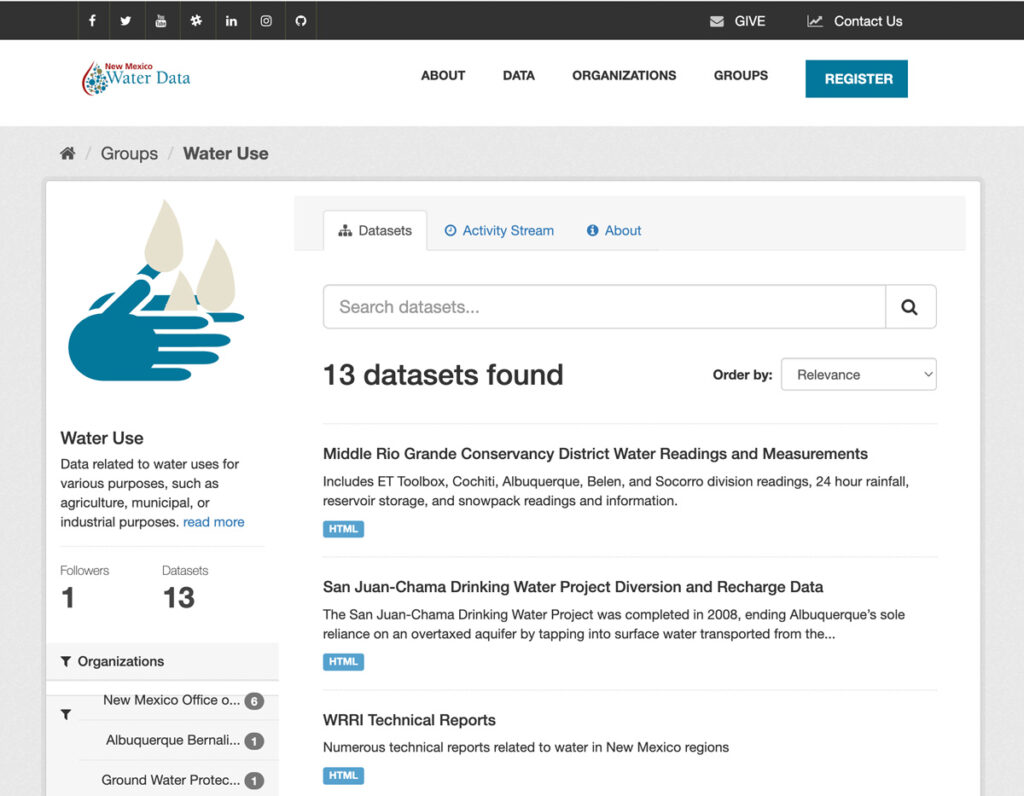
New Mexico Water Data
Created in 2019 after New Mexico enacted 2019 NM House Bill 651 to share, integrate and improve the management of water data, this page from New Mexico Water Data provides data related to water uses for various purposes, such as agriculture, municipal or industrial purposes. The 13 datasets available are intended to aid in effective water management and planning within the state.
Source: New Mexico Water Data
OSE Water Use and Conservation Programs
This page highlights the Water Use Program and Water Conservation Program that New Mexico’s Office of the State Engineer (OSE) created to inventory surface and groundwater withdrawals and depletions by category, county and river basin, and to coordinate water conservation activities for the state. Within these programs, you can find tools to aid in review of the state’s water use, like this spreadsheet-based calculator that helps quantify and track water uses associated with water distribution systems.
OSE Water Use and Technical Data List
Since 1990, New Mexico’s OSE has been collecting data concerning withdrawals and general water use from the Arkansas-White River Basin, the Lower Colorado River Basin, and the Rio Grande River Basin. This page categorizes withdrawals by each county’s usage within the state.
Source: New Mexico OSE
New Mexico water law and water rights
Water Rights Statutes, Rules, Regulations and Guidelines
Like regulation throughout the American West, rules and regulations governing the appropriation and use of water throughout New Mexico are well-defined. To help make sense of the regulations, this page on the OSE’s site describes the most important laws. In addition, OSE has provided a water rights lookup page to streamline the process.
Glossary of Water Terms
From “alluvium” to “xeriscape,” the OSE’s glossary of water terms provides definitions for key water terminology. This includes lingo, technical terms, statutes and legal terms, as well as relevant acronyms for organizations.
Key Water Law Cases
New Mexico’s body of water law is extensive. This paper from the University of New Mexico’s Utton Center includes a list with some of the key cases decided in the state and federal courts of New Mexico, including very brief descriptions of the rulings. The cases have been arranged by topic, such as groundwater rights, endangered species and ongoing litigation.
Rio Grande Basin
Rio Grande Basin Fact Sheet
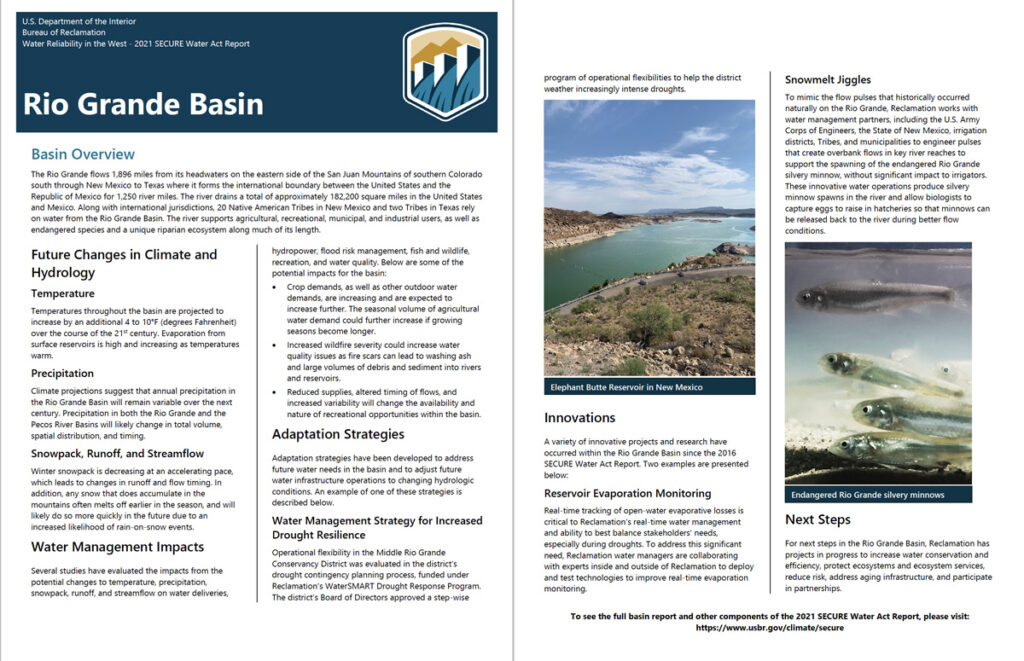
The Rio Grande flows through three states and forms the international boundary between the United States and Mexico on its nearly 1,900-mile journey to the Gulf of Mexico. Along the way, the river provides water to 22 Native American Tribes in New Mexico and Texas. This fact sheet provides information about the river basin, including climate, hydrology, management, and future strategies.
Source: U.S. Bureau of Reclamation
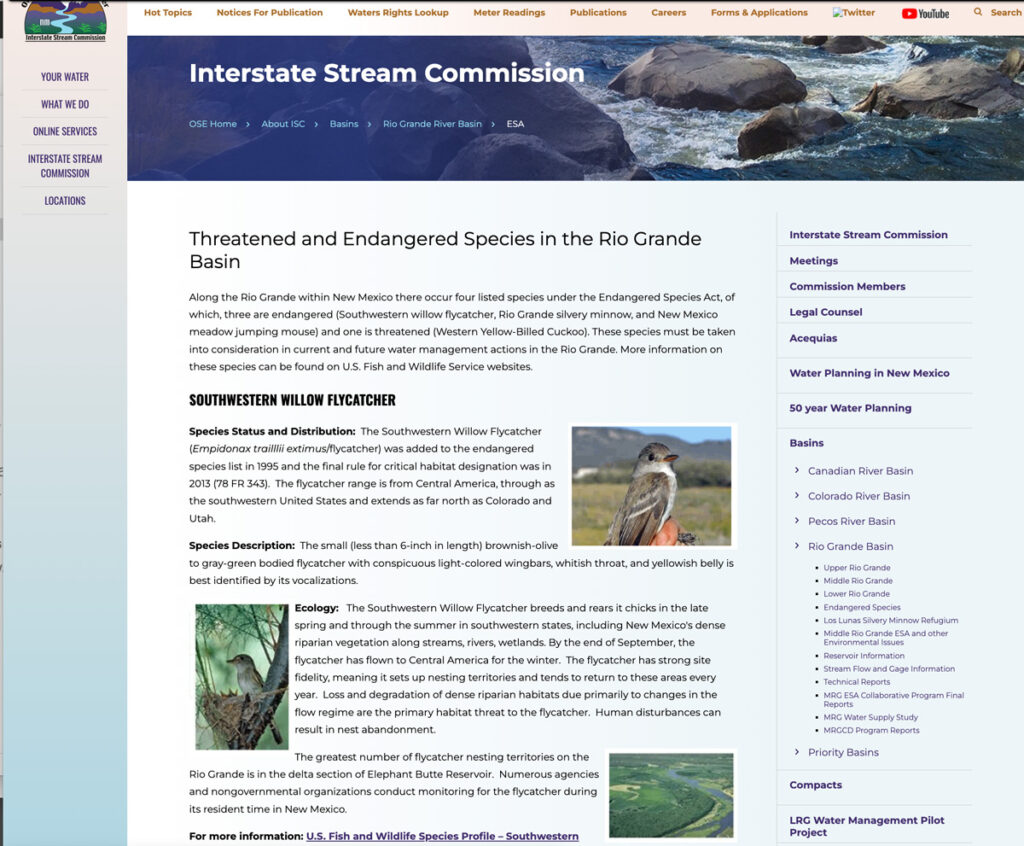
Rio Grande Basin Endangered Species
Along the Rio Grande within New Mexico, there occur four listed species under the Endangered Species Act, of which three are endangered (Southwestern willow flycatcher, Rio Grande silvery minnow, and New Mexico meadow jumping mouse) and one is threatened (Western Yellow-Billed Cuckoo). This page from OSE provides the status, distribution and ecologies for the listed species, including links to more information.
Source: New Mexico’s Office of the State Engineer
Rio Grande Basin Status Maps
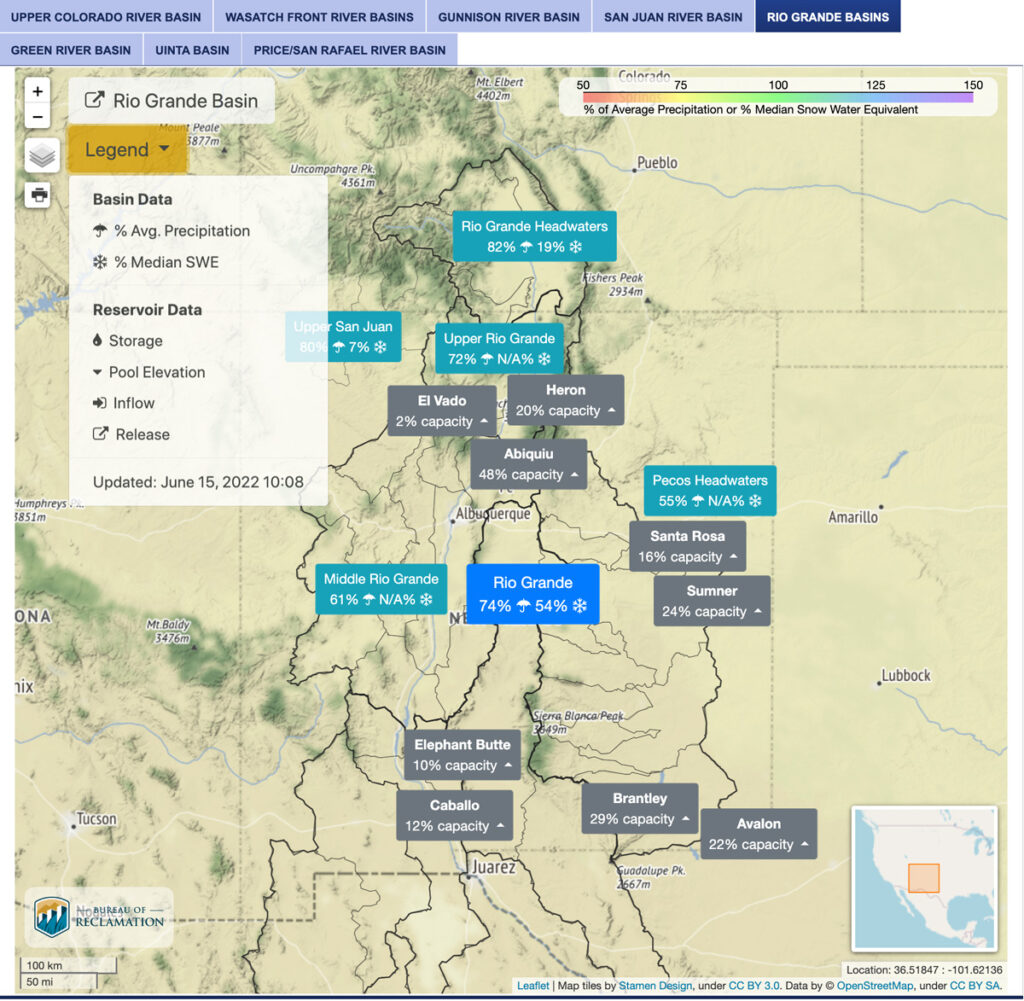
Source: US Bureau of Reclamation (click tab at top for “Rio Grande”)
Rio Grande Compact
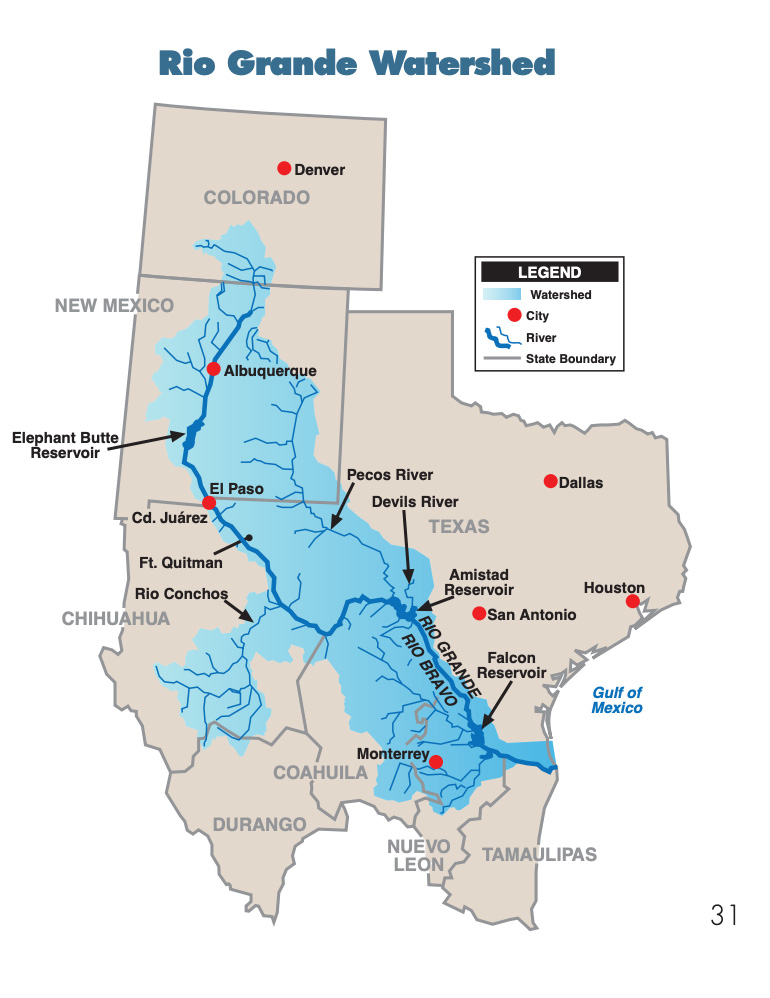
Rio Grande Compact – Wikipedia
The Rio Grande Compact is an interstate agreement between Colorado, New Mexico and Texas to apportion water from the Rio Grande Basin among the states. Signed in 1938, the compact acts as the foundational governing document over the basin’s water resources. During drought, New Mexico will often be short about 80,000 acre-feet in its obligations to deliver water to Texas.
Source: Texas Commission on Environmental Quality
Video: The Rio Grande Compact explained
The Rio Grande Compact is a critical document concerning the resources and ecology of the Rio Grande River Basin, but it’s also fairly cryptic, filled with terminology and legislation foreign to anyone who doesn’t work with the issue directly. This explainer from journalist and former Water Desk grantee Christi Bode distills the complex document into more digestible terms. From the video:
“Rivers are a shared resource. Like all rivers that originate in-state, Colorado must share the Rio Grande’s waters with its downstream neighbors. In the San Luis Valley, the 75-year-old Rio Grande Compact governs all things water. The river has been a source of tension, leading to litigation with New Mexico and West Texas, however, since 1966 Colorado has met all of its compact obligations.”
Source: Christi Bode via Vimeo
For more on the Rio Grande Compact, see this fact sheet on by Water Desk grantee Jerd Smith.
Government agencies
Colorado
Colorado: Rio Grande Basin Roundtable
The Rio Grande Basin Roundtable (RGBRT) is a group of representatives of water users in the basin who lead discussions on water management issues, educate Coloradans and engage communities in water-related projects and information. The RGBRT is composed of members of the public who represent the diverse agricultural, municipal, industrial, environmental and recreational water needs of the Rio Grande Basin. The group also collaborates with other roundtables in the state on Colorado water issues. Roundtable projects range from conservation easements and watershed restorations to educational initiatives.
New Mexico
New Mexico Office of the State Engineer (OSE)
The New Mexico Office of the State Engineer is the primary water agency in the state. The State Engineer, appointed by the Governor of New Mexico, serves as the agency’s director, and has authority over the supervision, measurement, appropriation and distribution of all surface and groundwater in New Mexico, including streams and rivers that cross state boundaries.
Texas
Created in 1957, the Texas Water Development Board (TWDB) is a full-time, three-member board appointed by the governor that leads the state’s water efforts. To do so, TWDB provides water planning, data collection and dissemination, financial assistance and technical assistance.
Source: Texas Water Development Board
Mexico
The International Boundary and Water Commission (or Comisión Internacional de Límites y Aguas, also known as “CILA”) is an international organization made up of a Mexican Section and a U.S. Section, each of which is directed by an Engineer Commissioner appointed by the president of their respective country. The headquarters of the Mexican Section are in Ciudad Juárez, Chihuahua and those of the United States Section are in El Paso, Texas. The commission’s mission is to “provide binational solutions to issues that arise during the application of United States – Mexico treaties regarding boundary demarcation, national ownership of waters, sanitation, water quality, and flood control in the border region.” The U.S. section of the International Boundary and Water Commission (USIBWC) is a federal government agency.
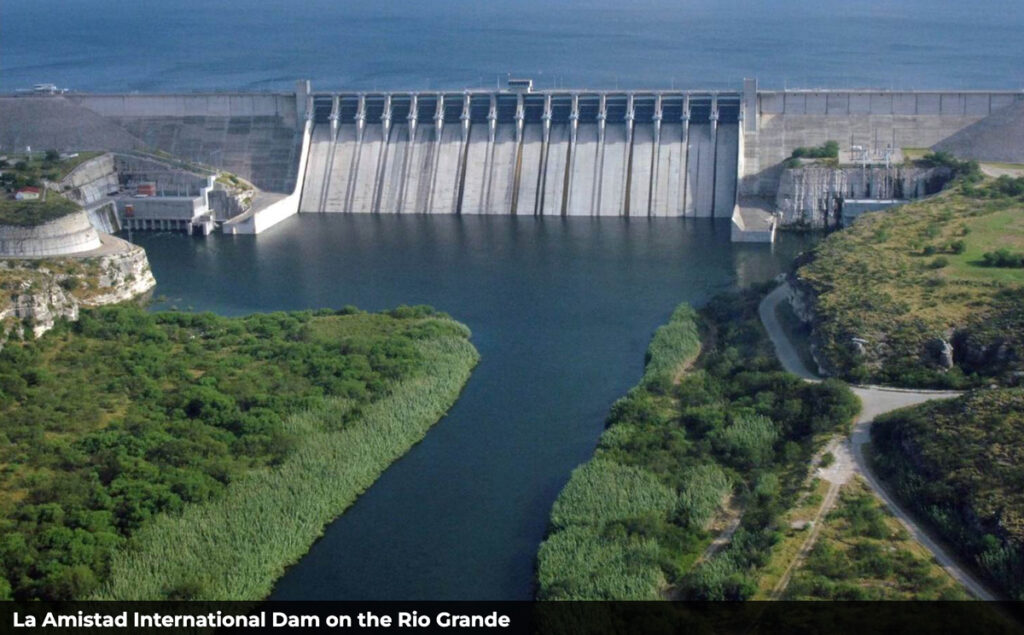
Source: Comisión Internacional de Límites y Aguas
Additional
The 1944 Water Treaty
The Water Treaty of 1944 took the already existing International Boundary Commission and expanded its jurisdiction to encompass water issues, rather than solely focusing on international boundary issues. As defined in 1944, the newly formed International Boundary and Water Commission (IBWC) is responsible for the:
- Demarcation of the land boundary
- Preservation of the Rio Grande and Colorado River as the international boundary
- Protection of lands along the rivers from floods by levee and floodway projects
- Distribution between the two countries of the waters of the Rio Grande and the Colorado River
- Regulation and conservation of the waters of the Rio Grande for their use by the two countries by joint construction, operation and maintenance of international storage dams, reservoirs and hydroelectric generating plant
- Delivery of Colorado River waters allocated to Mexico
- Solution of border sanitation and other border water quality problems.
Sharing the Rio Grande
The United States and Mexico share the waters of the Colorado River and the Rio Grande, and a bilateral water treaty from 1944 (the 1944 Water Treaty) and other binational agreements guide how the two governments share the water resources of these rivers. This document created by the Congressional Research Service (CRS) provides an in-depth history and review of the compacts as well as resource management strategies pursued by the two countries.
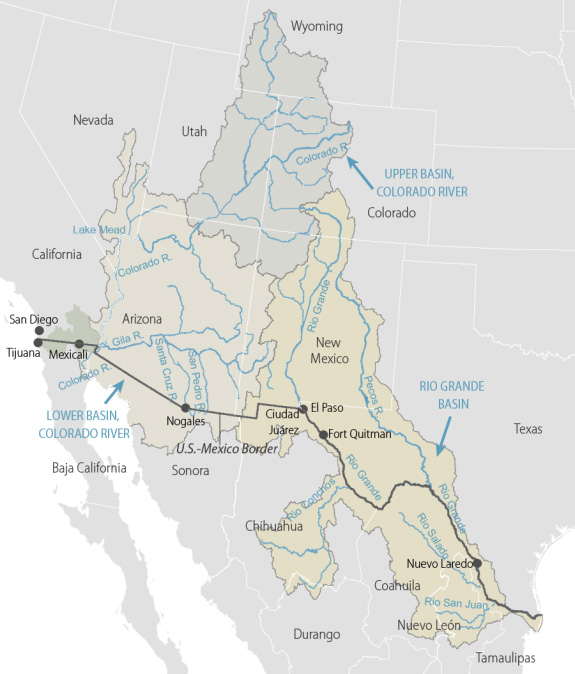
Source: Congressional Research Service (CRS)


